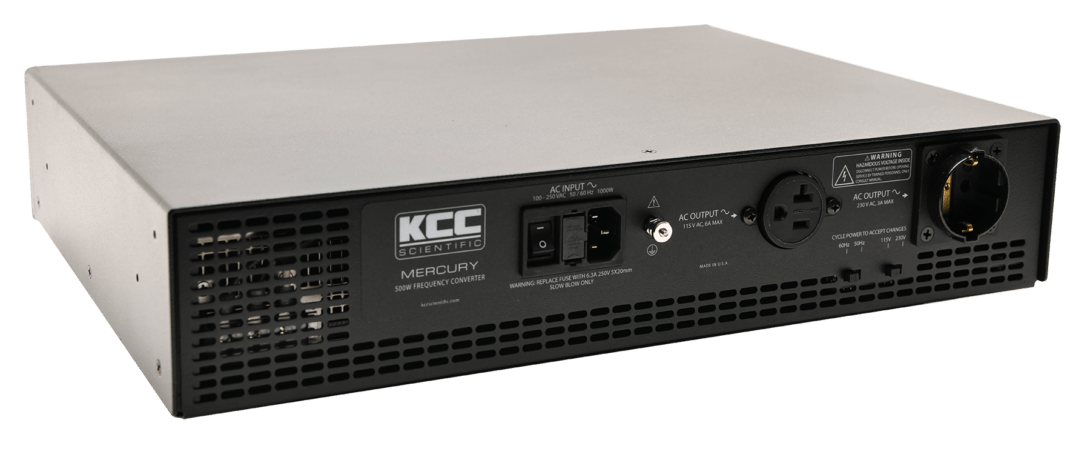To view frequency and voltage converters for purchase click here: SHOP
The Dirty Little Secret about Mains Power Line Frequency
The Frequency Accuracy of our Mains Power Line Grid.
We take it for granted. We plug our high-performance audio systems and clocks into it. We count on it being there when we need it to power everything from vacuum cleaners to washing machines. The playback pitch of our turntables, tape players, and the accuracy of our electric clocks depends on 60Hz (in the USA) being exactly 60Hz.
Of course, we’re talking about the frequency of our mains power line grid, delivered to us through our convenient wall outlets. We depend on it so completely that we forget how much can go wrong if it were to drift. But why worry? It’s been reliable all of these years; or has it?
If you ask some, you might hear that the mains power line frequency is quite accurate–almost a timing standard of sorts. But this simply isn’t always true!

Certainly in the US, the mains power line grid is complex beyond our imagination. With interest in grid augmentation through wind, solar and other means, plus the ever-increasing demand (yes, even in the winter!) to satisfy more and more energy-hungry customers, the grid is stressed beyond the limits it was originally designed to accommodate. The problem of Time Error Correction is becoming quite concerning. In the US, many industry experts feel we are reaching the end of an era, when Time Error Correction will be eliminated.
What is Time Error Correction, and Why Should Anyone Care?
Quite simply, Time Error Correction is the process by which the frequency of the mains power line is controlled by our utility companies. Contrary to the common misunderstanding of many, the mains power line frequency is NOT precisely controlled at any instant in time, or over the course of any given day. When demand is high, generators slow down substantially. The result of this load is that mains power line frequency drops–and often, dramatically.
The idea behind Time Error Correction (TEC) is that over a 24-hour period the total number of cycles is held constant. This is done by speeding up the generators in that timeframe, to compensate for slow downs due to load. So there you have it–if an overload happens which lowers the mains power line frequency, it is corrected by a DELIBERATE reaction of over-compensating by increasing the frequency, often dramatically! This also happens in reverse. In recent years, the error has often exceeded the limits set by the NERC (North American Electric Reliability Corporation) of under 0.083% excursion from the nominal value of 60Hz.
End to end, that’s a 0.166% change! Is that audible? You can decide; we know it is, at least to some. If you have a plug-in synchronous clock that depends on it, you can–and will–see variations over the course of the day in the clock’s timekeeping. We’ve recently observed some variations that approach 1 minute over the course of a day. And, it seems to be worse in recent years. It’s pretty obvious that something is going on.
This is a worldwide issue. In Europe, similar and perhaps worse problems have been reported by ENTSO-E. The origins of the problems are similar albeit not exactly the same. But in the end, it’s the same technical result–well, according to this link, actually worse! The data suggests the end to end variations there could approach 0.4%!
Some experts believe that as a consequence, TEC creates bigger problems than it solves, and are now looking to eliminate it. For us, that means anything in our systems that requires tight mains power line frequency accuracy may suffer. Will we be able to hear a 0.16% to 0.4% continuous shift and roll in mains power line frequency and thus playback pitch? Well, here we are, investing in the best equipment, highest-quality turntables, preamplifiers, etc., and everything else we can do to optimize sonic performance, and yet completely out of our control is the mains power line frequency–until now.
Perhaps during a simpler time, the mains power line frequency was fundamentally more accurate and stable, because the demands on the grid were simpler. Unfortunately that just doesn’t apply today.
The Remedy for Power Line Inaccuracy; Clean Power
At KCC Scientific, we have known about the vulnerability of TEC for years, and have been developing and producing products to re-create the mains power line frequency with more accuracy than TEC could ever produce. Our solution, mains reconstruction (patent pending) is consistent, stable, and reliable down to 0.0002%; from our original Chronos to our most recent Mercury After all, that kind of clean power is what our discriminating audio customers expect. Why settle for less? KCC Scientific voltage and frequency converters–all of them–perform at this level of excellence.
To view frequency and voltage converters for purchase click here: SHOP
Have questions? Contact us, we will help.Contact







